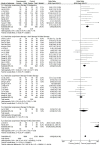Effects of auricular acupressure on dysmenorrhea: A systematic review and meta-analysis of randomized controlled trials
- PMID: 36686444
- PMCID: PMC9851274
- DOI: 10.3389/fendo.2022.1016222
Effects of auricular acupressure on dysmenorrhea: A systematic review and meta-analysis of randomized controlled trials
Abstract
Background: Auricular acupressure (AA) is widely used in treatment of dysmenorrhea, but the safety and efficacy of auricular acupressure on dysmenorrhoea are still lack of evidence-based basis.
Objective: The purpose of meta-analysis was to evaluate the effects of auricular acupressure on dysmenorrhea.
Data sources: A systematic search was conducted in six electronic databases, including PubMed, Embase, Cochrane Central Register of Controlled Trials (CINAHL), Weipu (CQVIP), China National Knowledge Infrastructure (CNKI), and Wanfang databases, to retrieve studies published from the inception dates to June 10, 2022.
Study selection: Randomized controlled trials (RCTs) that investigated the effectiveness of AA on dysmenorrhea were identified.
Data extraction and synthesis: The data extraction and quality assessment of the included studies were performed by two reviewers independently. Outcomes were abstracted to determine the effect measure by using mean differences (MD), standardized mean differences (SMD), or odds ratio (OR) from a random effects model.
Main outcomes and measures: Cure rate, total effective rate, and visual analogue scale (VAS) were described as primary outcomes; Short-form Menstrual Distress Questionnaire (MDQs), symptom scores, serum nitric oxide (NO) level, and adverse events were recorded as secondary outcomes.
Results: Thirty-five RCTs involving 3960 participants were included in this study. Our findings indicated that, overall, AA was associated with a significant benefit in cured rate (OR = 1.95, 95%CI: [1.34, 2.83], P=0.0004, I2 = 75%), total effective rate (OR = 3.58, 95%CI: [2.92, 4.39], P<0.00001, I2 = 67%), VAS score (MD = -1.45, 95%CI: [-1.73, -1.17], P<0.00001, I2 = 67%), and symptom scores compared to the control group (SMD = -0.85, 95%CI: [-1.28, -0.43], P<0.0001, I2 = 91%). However, no difference in serum NO (SMD = 0.77, 95%CI: [-0.39, 1.92], P = 0.19, I2 = 89%) and MDQs (SMD = -0.58, 95%CI: [-1.26, 0.10], P = 0.10, I2 = 79%) was found between the two groups. Furthermore, subgroup analysis results indicated that AA showed significant superiorities in increasing cured rate and total effective rate, and reducing VAS score and symptom scores when compared to analgesics and non-intervention. Moreover, AA presented the same superiorities when used as an adjunctive strategy to other therapy. However, these benefits were not detected in AA used alone when compared to the therapies, including Chinese herbs, acupuncture, external application of Chineseherbal medicine, moxibustion, auricular needle, and health education.
Conclusions: Overall, AA, as a potential safety therapy, is effective for the management of dysmenorrhea, such as increasing cured rate, total effective rate, VAS, and symptom scores. Nevertheless, AA showed no significant improvement in serum NO and MDQs. It is furtherly found that AA used alone is superior to analgesics and non-intervention regarding cured rate, total effective rate, VAS, and symptom scores. Furthermore, the same superiorities are observed when AA serves as an adjunctive strategy to other therapy. However, AA alone has little effect on them compared to other therapies, and there is no definite conclusion on the benefits of AA compared to placebo for patients with dysmenorrhea. Rigorous RCTs with blind method and placebo control are warranted to confirm these findings.
Systematic review registration: https://www.crd.york.ac.uk/prospero/, identifier CRD42022338524.
Keywords: auricular acupressure; dysmenorrhea; menstrual pain; meta-analysis; review.
Copyright © 2023 Kong, Fang, Li, Zhang and Guo.
Conflict of interest statement
The authors declare that the research was conducted in the absence of any commercial or financial relationships that could be construed as a potential conflict of interest.
Figures








Similar articles
-
Complementary and alternative therapies for post-caesarean pain.Cochrane Database Syst Rev. 2020 Sep 1;9(9):CD011216. doi: 10.1002/14651858.CD011216.pub2. Cochrane Database Syst Rev. 2020. PMID: 32871021 Free PMC article.
-
Effects of auricular acupressure on menstrual symptoms and nitric oxide for women with primary dysmenorrhea.J Altern Complement Med. 2009 Mar;15(3):235-42. doi: 10.1089/acm.2008.0164. J Altern Complement Med. 2009. PMID: 19292653 Clinical Trial.
-
Chinese herbal formula siwutang for treating primary dysmenorrhea: A systematic review and meta-analysis of randomized controlled trials.Maturitas. 2020 Aug;138:26-35. doi: 10.1016/j.maturitas.2020.03.009. Epub 2020 May 13. Maturitas. 2020. PMID: 32631585
-
Association of Acupuncture and Auricular Acupressure With the Improvement of Sleep Disturbances in Cancer Survivors: A Systematic Review and Meta-Analysis.Front Oncol. 2022 May 18;12:856093. doi: 10.3389/fonc.2022.856093. eCollection 2022. Front Oncol. 2022. PMID: 35664757 Free PMC article.
-
Acupuncture and acupressure for premenstrual syndrome.Cochrane Database Syst Rev. 2018 Aug 14;8(8):CD005290. doi: 10.1002/14651858.CD005290.pub2. Cochrane Database Syst Rev. 2018. PMID: 30105749 Free PMC article.
Cited by
-
Auricular acupressure for insomnia in women with breast cancer: A systematic review and meta-analysis of randomized controlled trials.Medicine (Baltimore). 2025 Feb 14;104(7):e41498. doi: 10.1097/MD.0000000000041498. Medicine (Baltimore). 2025. PMID: 39960920 Free PMC article.
-
Auricular Acupuncture Prior to Menstruation Can Reduce Primary Dysmenorrhea: A Randomized Controlled Trial.Med Acupunct. 2024 Feb 1;36(1):12-20. doi: 10.1089/acu.2023.0062. Epub 2024 Feb 13. Med Acupunct. 2024. PMID: 38380169 Free PMC article.
-
Efficacy and Safety of Non-Pharmacological Therapies for Primary Dysmenorrhea: A Network Meta-Analysis.J Pain Res. 2025 Feb 27;18:975-991. doi: 10.2147/JPR.S498184. eCollection 2025. J Pain Res. 2025. PMID: 40034106 Free PMC article. Review.
-
Comparative efficacy of pharmacological and non-pharmacological interventions on pain intensity of primary dysmenorrhoea: protocol for systematic review and network meta-analysis.BMJ Open. 2025 Jul 6;15(7):e089282. doi: 10.1136/bmjopen-2024-089282. BMJ Open. 2025. PMID: 40623753 Free PMC article.
-
Effect of auricular acupressure combined with acupuncture for juvenile pseudomyopia.Medicine (Baltimore). 2023 Sep 15;102(37):e35018. doi: 10.1097/MD.0000000000035018. Medicine (Baltimore). 2023. PMID: 37713874 Free PMC article.
References
-
- McKenna KA, Fogleman CD. Dysmenorrhea. Am Fam Physician. (2021) 104(2):164–70. - PubMed
Publication types
MeSH terms
Substances
LinkOut - more resources
Full Text Sources
Medical

